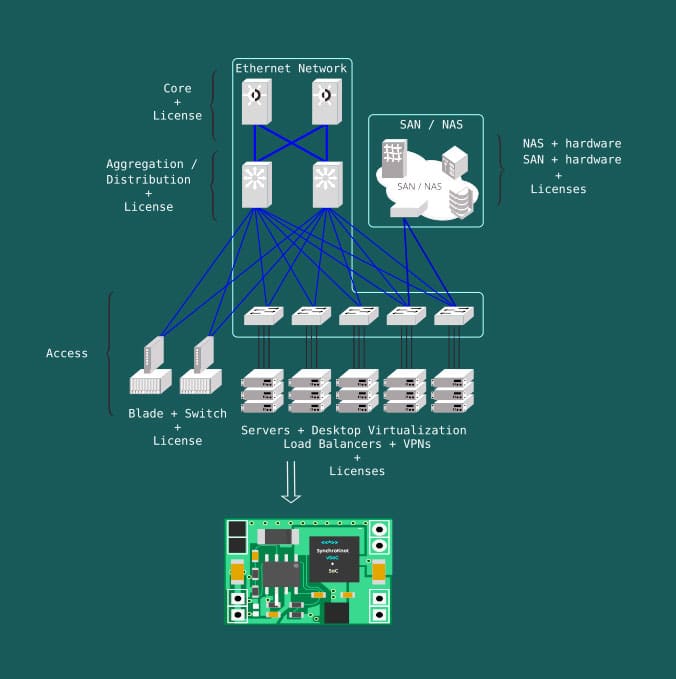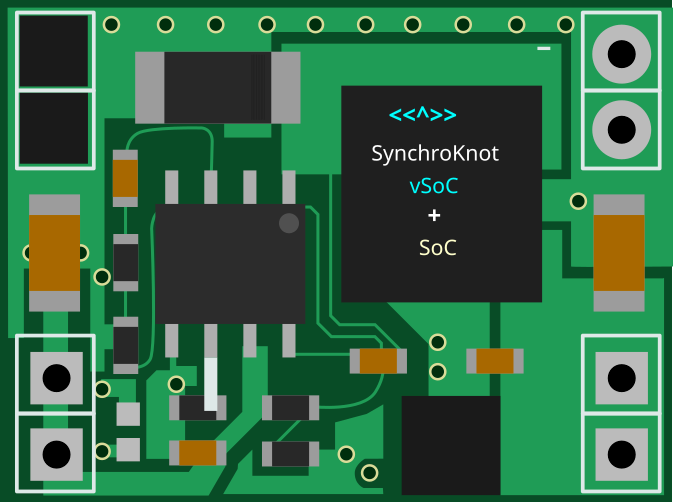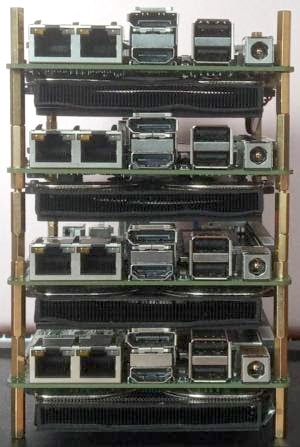Cloud computing and data centres are the backbone of the current global digital economy. There is a standard architecture for implementing cloud computing, which is centralised in terms of location, but disparate in terms of hardware and software. SynchroKnot offers a decentralised software solution for embedded platforms, which allows for complete cloud computing solutions on a virtual System on Chip (vSoC).
Cloud computing allows manipulating, configuring, and accessing hardware and software resources remotely. It makes our business applications mobile and collaborative, but needs an extensive IT infrastructure. A standard infrastructure consists of virtualisation software such as VMware, OpenStack, Hyper-V, RHEV, Xen, VDI, etc. Below the virtualisation layer, these virtual machines run on servers. The data gets stored in SAN/NAS or other distributed block storage. All these systems are connected by redundant switches and routers.
The challenge with this kind of architecture is that you need to purchase expensive disparate hardware like servers, redundant switches and routers, as well as storage and load balancers. You also need to buy virtualisation software with licences, and licences for hardware and storage. Different hardware and software must be separated through management panels, APIs and user interfaces. Moreover, a large space is needed to house expensive hardware with thermal management solutions, and a whole multi-tiered team is required to manage the complex operations.
The complexity increases further when scaling this architecture. To overcome these difficulties, SynchroKnot, along with ASRock, its hardware partner from Taiwan, has created an elegant alternative to cloud based architecture. The solution consists of a virtual System on Chip (vSoC) which literally acts as a server. Each core of the SoC runs at around 4.2GHz without overclocking. One can run widely accepted tools like OpenStack on this hardware itself. The hardware comes with built-in virtual switches to ensure a standard configuration.

one vSoC + SoC (Image courtesy of SynchroKnot)
In traditional cloud based architecture, the data gets stored in SAN/NAS. The data in the case of SynchroKnot gets stored in a file storage system, which is mainly a hard drive. The data storage capacity depends on the hard drive, and the amount of data storage needed depends on the applications running the virtual machines. Because the virtual machines operate directly on SoCs and storage is directly connected, the system can run high performance databases very rapidly. And the decentralisation makes this system far simpler.
The supported hardware recommended to run these services are AMD CPUs from ASRock Industrial Computer Corp. Two of the recommended hardware are the 4800U motherboard and the V2000M consisting of up to 16 threads. With these, getting started with SynchroKnot solutions is easy. This hardware has certain unique features like accessing BIOS remotely.
The hardware is an embedded motherboard. The reason for calling it an SoC is its 10.2cm x 10.2cm (4×4 inch) form factor. You can directly install your operating system on this SoC. You can use any AMD x64 CPU for installing SynchroKnot services, but the aforementioned hardware is certified by SynchroKnot and is highly recommended. Also, a thick robust power supply will be required to run SynchroKnot services on other embedded hardware.
In a nutshell, this is a complete cloud solution on a SoC. You need an external memory storage solution, but as it is directly connected, data transfer is very fast. Moreover, no disparate hardware like switches and routers are required to implement this architecture.
Who are these services intended for?
Anyone can choose this solution for personal usage instead of buying cloud services like Amazon AWS and Google Cloud. The threads and cores in SoCs can be separated to provide access to tenants, who can be partners or customers. SynchroKnot can be stacked anywhere in the world and can remotely access virtual machines as tenants.
Services can also be provided based on SynchroKnot infrastructure. For this, one has to become a SynchroKnot certified systems integrator. One can then provide SynchroKnot solutions and hardware to clients, and guide them through.

The learning curve for adopting this new technology
Let’s say, an organisation uses centralised management facilities such as vCenter, Microsoft Virtual Machine Manager or Xen locally, and runs virtual machines on them. The next layer is connection with cloud services. With SynchroKnot, things get much simpler. It takes 12 seconds to install on a 2-core machine. After installation, one can log in from the graphical user interface (GUI) itself, and all other virtual machines logged in as tenants can be seen on the GUI.
With this solution, one can mirror the virtual machines on another site. No extra skills or knowledge are required for this. The data manipulation that has to be done while using cloud services in the database for proper GUI is not required here. Almost everything is automatic, and there is no need to go to the command lines unless spatial clusters are being done for the very first time.
The OS is Debian, which is one of the most secure operating systems. Once the OS is installed, one needs to follow the demo videos from https://synchroknot.cloud/ to install the entire SynchroKnot within seconds. One can stack it up, and there is no need to configure anything in terms of switching, physically or virtually. One can connect ports in any topology such as star, tree, etc.
Therefore, an organisation can actually transition to SynchroKnot without having to change anything, because it supports VMware and all other standard OpenStack virtualisation technologies.
The whole setup is scalable — virtual machines can be added by adding hardware modules. For installation, Ethernet cable is required, and the GUI automatically loads up in added hardware. All that is needed is to select SynchroKnot from the GUI and everything gets aligned.
The entire system aims for decentralisation. It decentralises from the hierarchy, yet maintains some hierarchical support so one doesn’t get flooded in a huge mass of machine protocol.
How does the vSoC provide security to the infrastructure?
One of the main highlights of a SynchroKnot vSoC is its security engine, which caters to the network layer as well. The engine provides decentralised real-time authentication and authorisation of users to vSoC, users to virtual machines, and virtual machines to other virtual machines. All this while still maintaining LDAP, active directory, SSH (secure shell), and much more.
The decentralised blockchain identity management system uses fast blockchain cryptography in real-time to confirm user identity. Blockchain SSH allows transparent fast login to virtual machines using a standard user name. Moreover, the security engine features AuthControl, a distributed fault-tolerant system that serves as a scalable, secure and simple alternative to LDAP, active directory and other systems.
The ARPLess interstellars are offered as power modules. They enable network bifurcation and security at layer 2 across stacked or unstacked virtual LAN connections. A 28-bit interstellar identification is assigned to the virtual machine interface. Only virtual machines with the same interstellar identification can communicate with each other, irrespective of their location.
The ARPLess interstellars create a secure vacuum for trusted communication within virtual machines. They do not allow forced traffic diversion from poisoned ARP caches of virtual machines to reach undesired destinations. Plus, they ignore requests from virtual machines that impersonate the original to force diversion of traffic or gain access.
In this way, the security engine ensures that there are no chances of session hijacking.
The business opportunities in India
SynchroKnot presents an amazing opportunity for systems integrators to provide great RoI solutions to customers. Certified systems integrators can provide SynchroKnot solutions to their clients along with the hardware from ASRock. For being a certified systems integrator, one needs to have a clientele background in Linux. After certification, systems integrators can brand the services and sell on their own.

How does product delivery work and what is the price structure?
SynchroKnot services have to be bought from systems integrators locally, and hardware can be ordered from the systems integrator or directly from the ASRock website.
SynchroKnot solutions need vSoC software along with their licences. There is no requirement for physical or virtual switches, SAN/NAS distributed block storage, or a team to manage the whole infrastructure. SynchroKnot software and hardware seamlessly control and manage all virtual machines, and no large space is required for that. This helps decrease costs significantly, while still maintaining a high level of performance, scalability, security, and overall responsiveness and control.
The base price for a SynchroKnot vSoC licence is 100 euros, and first time registrants are required to purchase the ‘Starter’ package consisting of four Base TYPE-A-16 vSoC licences for 6400 euros.
One important thing to note is that SynchroKnot servers cannot be stationed in the United States, Germany, England, Spain, Ireland, France, and Italy. However, one can have servers in any other region and provide customer service in those countries.











































































